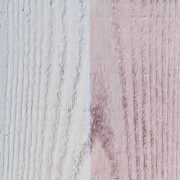Tannin Staining
Definition
Tan or brownish discoloration on the painted surface. Tannins are naturally found in many woods, like cedar and redwood. They may bleed through the coating and leave a yellowish-brown mark. These stains tend to be more visible on light paint colors.

What Is Tannin Bleed?
Tannin bleed happens when tannins in wood rise to the surface and discolor the paint. It usually appears as yellow or brown stains, especially when using light-colored paint. Woods like cedar and redwood are more likely to bleed, especially when exposed to moisture or high humidity. Tannin bleed is common during the first year after painting new wood.
Causes
- Failure to adequately prime and seal the surface before painting
- Using a primer that does not resist tannin stains
- High humidity or ongoing moisture issues that draw tannins to the surface
Solutions
- Identify and fix any moisture source
- Scrape off loose paint using a scraper or wire brush
- Remove visible stains using oxalic acid or an oxalic-based cleaner
- Rinse the area with a pressure washer
- Let the surface dry completely for at least 48 hours (weather dependent)
- Prime the affected area with a high-quality, stain-blocking wood primer
- For heavy staining, apply two coats of primer and ensure edges and ends of shingles are fully coated
- If possible, prime the backs of shingles before installation
- Finish with a coat of high-quality exterior paint
How to Prevent Tannin Stains
- The best way to prevent tannin stains is to block them before they appear.
- Use a primer made to resist tannin bleed on woods known to stain.
- Make sure the surface is dry and clean before priming.
- Avoid painting during wet or humid conditions and allow full drying time between coats.
- Choose a high-quality paint and apply it according to the manufacturer’s instructions.
Notes
Tannin bleed is a surface problem, not a paint failure. Tannic acid prolongs the drying of oil-based primers, and in some cases, you will have to wait three to five days for the primer to fully cure before repainting. If staining occurs during the application of the new coat of paint, sand lightly and re-prime the area before applying the final finish.
In spite of all precautions, a certain amount of bleeding will probably occur within one year after the wood is first painted. It is best to wait one year before repainting. This allows the tannins to surface and weather away normally.
Product Recommendations
Primer
Desired Finish
Recommended Primer
Natural Wood
Exterior
Surface
Recommended Product
Satin/Low Sheen
Please note that these suggestions are provided as a service to you. We are unable to guarantee or be responsible for the results obtained by these procedures. If you have additional questions, ask any of our expert sales associates.






